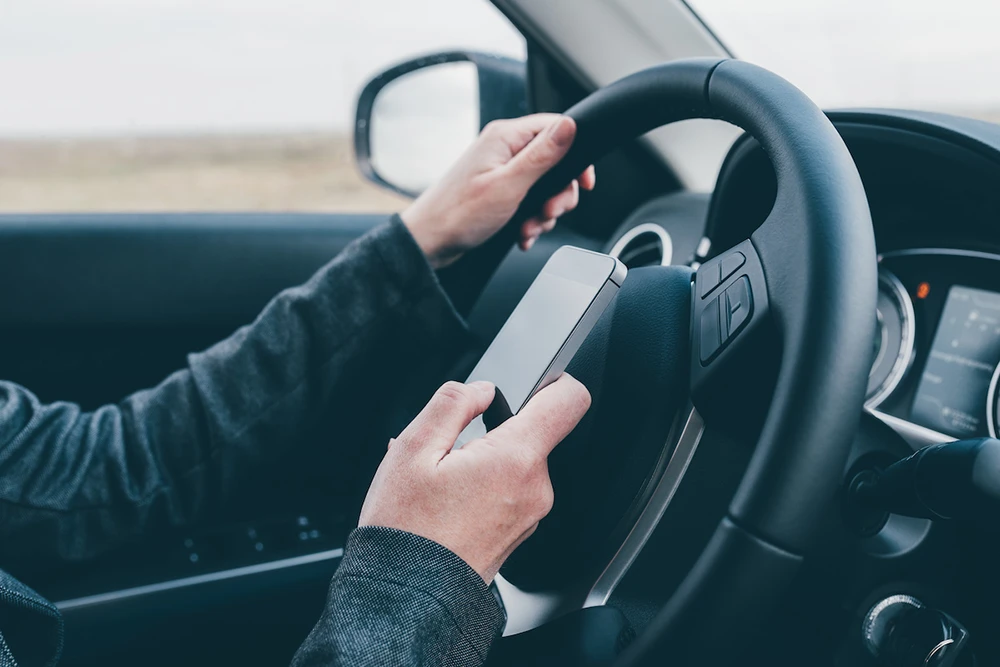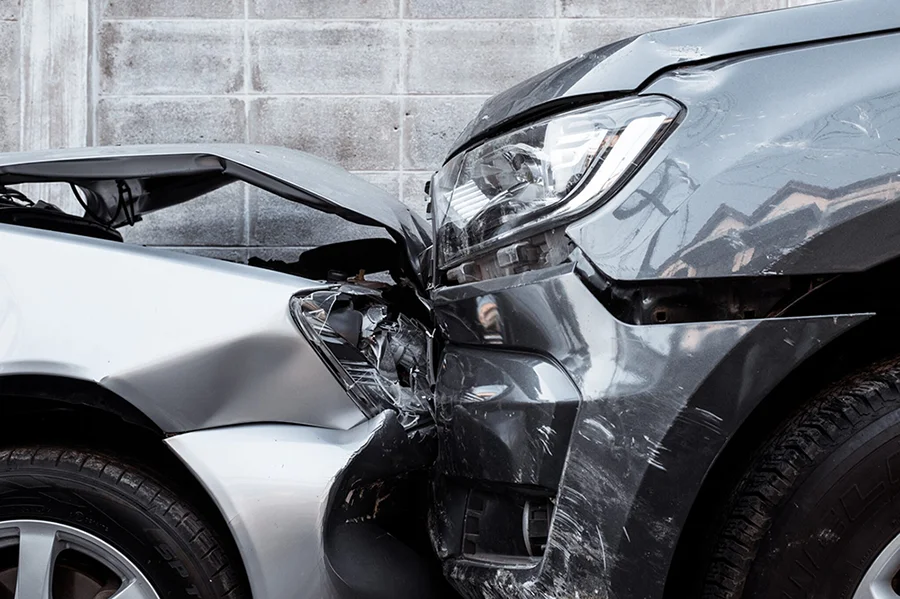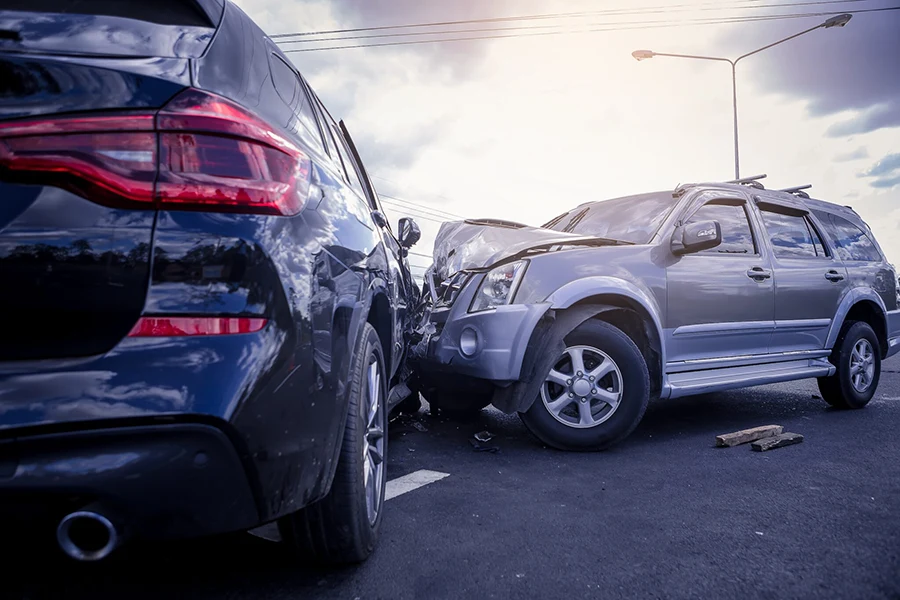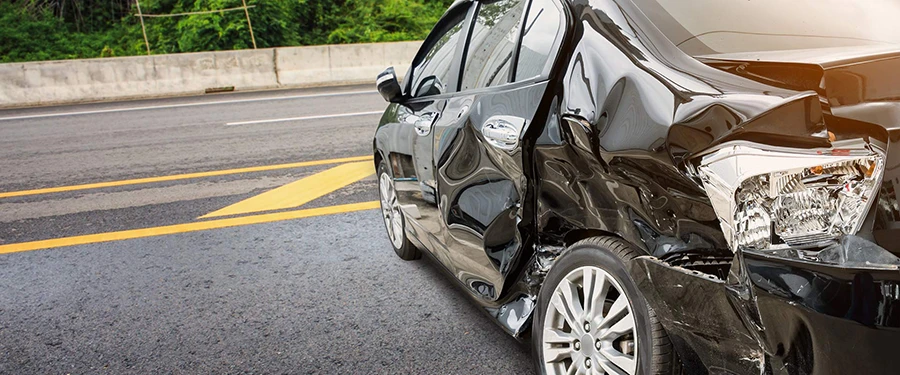
Automobile collisions can result in devastating and catastrophic personal injuries or death. Although these collisions arise out of a variety of circumstances, a catastrophic car accident or collision is typically due to a driver’s failure to obey common sense safety rules or to exercise reasonable care. Other times, it can be due to poor road design or even vehicle defects.
The Simon Law Firm, P.C. specializes in handling injuries caused by motor vehicles, whatever the cause may be. Learn more about the top causes of car accidents below:
1. Speeding
Speeding causes a lot of serious auto accidents every year. Drivers speeding have contributed to nearly ⅓ of all car accidents over the last two decades, and in 2020 alone, it caused the deaths of 11,258 people.
Not only does speeding endanger the lives of everyone on the road, it also:
- Creates the greater potential for losing control of a vehicle
- Gives you and other drivers less time to react
- Increases the forces suffered by the human body in the event of a collision
- Increases the extent of personal injuries, especially at high speeds
Speed limits exist for the protection of all road users but these are only considered safe in ideal conditions. Depending on prevailing weather, existing road hazards, and road conditions, driving the speed limit might actually be incredibly dangerous. In any regard, speeding is a conscious choice that deliberately and needlessly puts yourself and other drivers at risk of serious injury or death.
2. Distracted Driving
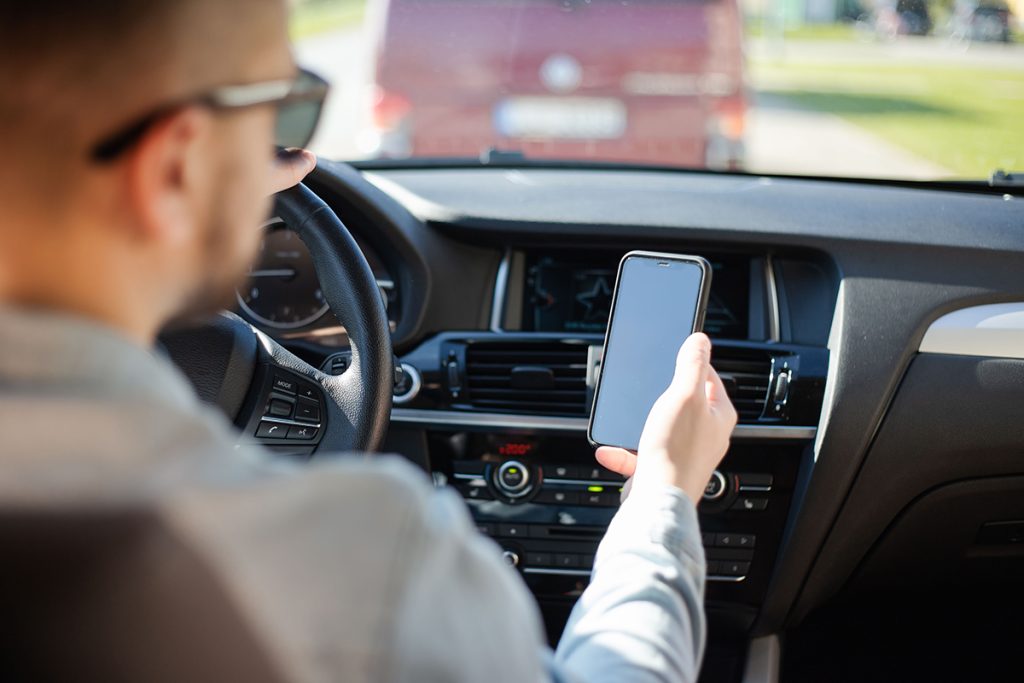 Every driver should follow the number one rule: Keep your eyes on the road. Many injuries and death would be prevented if drivers follow this common sense safety principle. Unfortunately, St. Louisans know that rule is routinely and commonly ignored—St. Louis is ranked number 3 in the U.S. when it comes to distracted driving accidents.
Every driver should follow the number one rule: Keep your eyes on the road. Many injuries and death would be prevented if drivers follow this common sense safety principle. Unfortunately, St. Louisans know that rule is routinely and commonly ignored—St. Louis is ranked number 3 in the U.S. when it comes to distracted driving accidents.
Distracted driving is “any activity that diverts attention from driving.” This includes things that physically and cognitively distract us. The most common distractions while driving include:
- Cell phone use while driving
- Manipulating audio or navigation systems
- Interacting with passengers
- Eating
Each year in the U.S., about 3,000 people are killed in crashes that involve a distracted driver. In 2019, over 3,100 people were killed by distracted drivers – 1 in 5 of which were pedestrian accidents – and roughly 424,000 were injured.
Taking your eyes off the road for any reason increases the risk of a catastrophic accident and is a conscious disregard for the safety of others.
3. Tailgating
Everyone has had the experience—a driver riding your tail and following too closely. Tailgating is more than a simple frustration; it is a leading cause of serious car accidents, especially at high speeds or in slick road conditions.
Tailgating can lead to many violent rear-end collisions. The National Highway Traffic Safety Administration indicates that 23 percent of all motor vehicle crashes are rear-end collisions, leading to 2,000 deaths and 950,000 injuries every year.
Consider perception/reaction time. The amount of time it takes an alert driver to perceive and react to an emergency is about 1.5 seconds. This means that at 60 MPH, your vehicle is going to travel about 90 feet before you even begin to react to an emergency. Taking into consideration braking distance, it takes a bare minimum of 240 feet to come to a stop at 60 MPH. If a driver fails to keep an adequate distance between his or her vehicle and yours, an accident is inevitable. You cannot beat physics.
4. Failing to Yield the Right of Way
Yielding the right of way is one of the most fundamental elements of responsible driving. It is the bedrock of our road and highway systems and is also one of the most basic rules every driver learns in Driver’s Ed.
The “right of way” is a set of rules all drivers are required to follow to ensure the safe flow of traffic. Unfortunately, these rules are often ignored by drivers who think they own the road, which can result in permanent injuries and deaths.
Failing to yield the right of way is responsible for some 4% of all traffic and intersection accidents.
Some examples of failing to yield the right of way include:
- Failing to obey stop signs or yield signs
- Failing to yield to pedestrians or bicyclists
- Running stop lights
- Making improper or illegal turns or u-turns
- Returning to the roadway from a parking lot
- Turning when it is not safe to do so
Drivers who fail to obey the right of way and ignore the rules of the road put everyone else at risk of needless injury and preventable death.
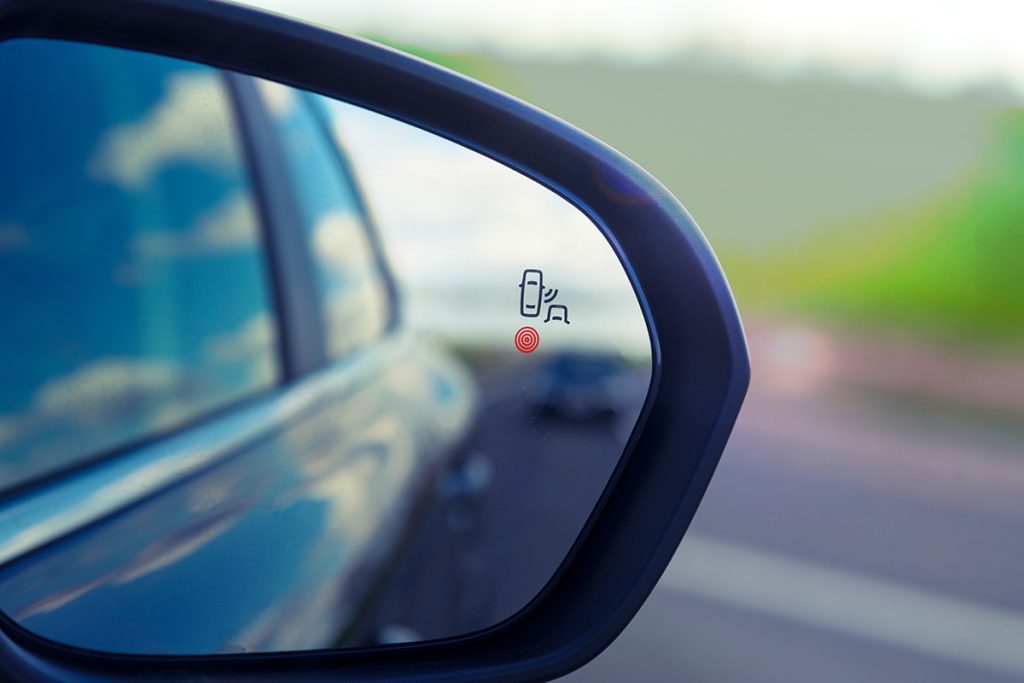
5. Failing to Check Blind Spot
A blind spot is any area where a person’s view is obstructed while operating a motor vehicle. In most passenger vehicles, the blind spot is located over the right or left shoulder of the driver. These accidents typically occur when merging or changing lanes.
As drivers, we are taught about the presence of blind spots and how to check for them before embarking on our journey. Emerging crash-avoidance technologies—such as blind spot detection systems—attempt to either eliminate blindspots or alert drivers when a person or vehicle is in a blind spot.
When drivers fail to adequately check blind spots, are too distracted to obey alerts, or simply ignore them, accidents can occur.
6. Texting While Driving
The newest—and perhaps the deadliest—scourge of automobile collisions and accidents is texting while driving. This includes not only sending text messages, but also surfing the web, checking social media, or otherwise fiddling with their devices.
There is no national ban on texting or using a cell phone while driving, but state laws that are becoming more and more stringent have emerged. Missouri law currently only bans drivers under the age of 21 from texting while driving. This distinction is meaningless because texting while driving is dangerous at any age. In a survey of 2,600 Americans aged 18 to 78 who drive regularly, nearly two-thirds agreed with the statement: “I know I shouldn’t use my phone while driving, but I do, anyway.”
Studies show:
- Sending or reading a text message may only take about 5 seconds normally but, at 55 MPH, that’s like driving the length of an entire football field with your eyes closed.
- Texting while driving is six times more dangerous than driving while intoxicated.
- Cell phone use behind the wheel reduces the amount of brain activity associated with driving by 37%.
- Texting reduces a driver’s physical and cognitive ability to control their vehicle or react to traffic conditions. At the right speed, this is a perfect combination for a deadly accident.
Sometimes, it can become a “he said, she said” situation when determining if a driver was at fault due to texting or phone usage. If you have been hit by a distracted driver on a cell phone, our road accident lawyers in St. Louis will work to preserve the cell phone and its data to prove it was in use. This includes having one of our consultants download the other party’s cell phone data and creating a report that can show exactly what the other driver was doing at the time of the collision.
7. Drunk Driving or Driving While Under Influence of Drugs
Driving while drunk or intoxicated is a deadly cause of violent automobile accidents. Alcohol impairs brain function, including thinking, decision-making, and muscle coordination. This makes driving while intoxicated incredibly dangerous.
For example, it impairs the driver’s ability to react to the road and people around their vehicle. This can create especially violent crashes because the drunk driver does not take any action to avoid or lessen the impact of the crash.
Choosing to drive while intoxicated is, plain and simple, a conscious disregard for the safety of other drivers on the road. In this day and age where an Uber or taxi ride is at your fingertips, there is no excuse for driving while intoxicated.
Driving while intoxicated is illegal in Missouri. This includes driving while impaired by alcohol or other substances such as marijuana or opioids. Drunk/impaired drivers are typically habitual offenders, so this is where our investigation starts. We will work to uncover things like whether this was a driver’s first offense, who provided the driver with the alcohol (to investigate third party or dram-shop liability), and what the driver’s activities were in the weeks and months preceding the accident.
Every day, almost 30 people die in drunk-driving crashes—that’s one every 50 minutes—and a person is injured in a drunk driving crash every 2 minutes. These deaths cause devastation among families. It deprives children of their parents. It deprives parents of their children. We work tirelessly so that your loved one, whether injured or killed, is not simply another statistic.
8. Driving While Drowsy, Tired, or Fatigued
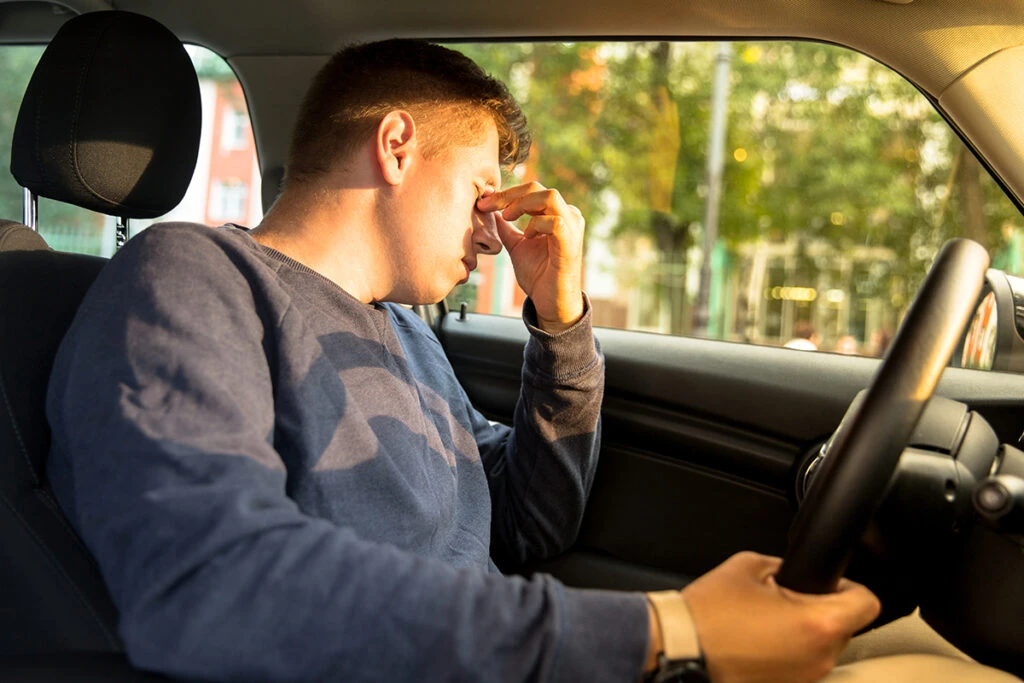 Unfortunately, some drivers get behind the wheel of a vehicle when they are drowsy, tired, or extremely fatigued. This usually happens when a driver has not slept enough, but can also happen because of untreated sleep disorders, medications, alcohol, or lengthy shift work.
Unfortunately, some drivers get behind the wheel of a vehicle when they are drowsy, tired, or extremely fatigued. This usually happens when a driver has not slept enough, but can also happen because of untreated sleep disorders, medications, alcohol, or lengthy shift work.
Driving under such conditions decreases a driver’s ability to pay attention to the road, slows reaction time, and affects cognitive ability to make good decisions. Drowsy driving can be similar, if not identical, to drunk driving. Some states have even made driving while drowsy a crime.
Drowsy driving can occur anywhere and anytime, but it most frequently happens:
- Between midnight and 6 AM
- With single drivers (and no passengers)
- On dimly lit or rural roads and highways
Drowsy driving can result in driver errors like crossing the centerline, driving the wrong way on the highway, running off the road, rear-ending traffic in front of them (often at highway speeds), or blowing through an intersection controlled by traffic signals. Each circumstance can lead to a deadly and explosive collision that may result in injuries or death.
Drowsy driving is dangerous and a major problem in the United States. Shockingly, an estimated 1 in 25 adult drivers (aged 18 and older) report having fallen asleep while driving in the previous 30 days. For commercial drivers, there are federal motor vehicle safety regulations that are aimed at preventing them from engaging in drowsy or fatigued driving, such as regulations imposing limits on how much and how often drivers can be on the road.
9. Aggressive or Reckless Driving
Aggressive driving occurs when a driver, for whatever reason, operates a vehicle in a manner that purposely disregards safety and courtesy. The technical definition, as used by the National Highway Traffic Safety Administration, is committing “a combination of moving traffic offenses so as to endanger other persons or property.” It is the hallmark of irresponsible vehicle use.
Missouri does not maintain a statute that uses the term “reckless driving.” Instead, Missouri Rev. Stat. § 304.012 requires drivers to operate their vehicle “in a careful and prudent manner and at a rate of speed so as not to endanger the property of another or the life or limb of any person and shall exercise the highest degree of care.”
Determining whether a person operates a vehicle in a manner that violates this statute is left to the discretion of law enforcement.
Aggressive or reckless driving comes in many shapes and forms, including:
- Speeding
- Changing lanes without a signal
- Crossing double yellow lines
- Tailgating
- Weaving through traffic
- Running cars off of the road
- Failing to heed traffic signals or yield the right of way
Aggressive driving is responsible for a significant proportion of all car crashes. Some studies estimate aggressive drivers kill two to four times more people than drunk drivers.
In most cases, gross violations of the rules of the road can amount to negligence per se and can justify a claim for punitive damages.
10. Mechanical Defects or Failing to Maintain Vehicle
Not all accidents can be made attributable to driver error. Rather, the cause of some serious accidents is set in motion by the choices that some drivers make before ever getting on the roadway, including by failing to properly maintain or service their vehicle.
Drivers are required to exercise reasonable care in maintaining their vehicle, including checking for wear on tires, ensuring that the vehicle’s brakes work, taking warning lights on the dashboard seriously, and bringing vehicles to qualified mechanics for regular maintenance to reduce the chances of causing an accident. Any vehicle defects found should be remedied as quickly as possible to prevent potential accidents.
In cases involving vehicle defects or poor vehicle maintenance, there may be more than one party at fault if maintenance records indicate recent work was complete. Other parties may include the last mechanic or service business who had their hands on the part that malfunctioned.
11. Negligently Entrusting a Vehicle
Be careful as to who you let borrow your motor vehicle. In some circumstances, vehicle owners can be responsible for what other drivers do or fail to do in their vehicles, even if the owner is not present at the time of the accident.
An example of negligent entrustment is lending a vehicle to someone who is:
- Drunk or intoxicated
- Incapable of operating a motor vehicle
- Known to be a reckless and unsafe driver
In Matysyuk v. Pantyukhin, 595 S.W.3d 543, 549 (Mo. Ct. App. 2020), the Missouri Court of Appeals set forth the elements that must be proven to maintain a claim for negligent entrustment of a motor vehicle:
- The entrustee was incompetent by reason of age, inexperience, habitual recklessness or otherwise;
- The entrustor knew or had reason to know of the entrustee’s incompetence;
- There was entrustment of the chattel;
- The negligence of the entrustor concurred with the conduct of the entrustee to cause the plaintiff’s injuries.
Incompetence of the entrustee can be shown by obtaining evidence of recklessness committed by them, such as past accidents, moving violations, substance abuse problems, a criminal record, or past reckless driving acts.
How a Car Accident Lawyer Can Help
If you have been involved in an accident, the St. Louis car crash lawyers at The Simon Law Firm, P.C. are here for you. We understand the complexities of accidents involving other drivers and we leave no stone unturned in our investigation of your case. We will have our expert consultants inspect the scene and the vehicles involved in the accident as well as work to preserve evidence that can help prove your claim. We handle all of the details so you can focus on your health and recovery.
From settlement negotiations with insurance companies to filing a lawsuit to bring your case before a jury, The Simon Law Firm, P.C. is dedicated to fighting for you and resolving your case in your favor. Contact us today for a free case evaluation.
